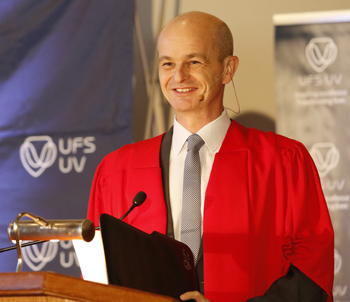
Colm McGivern
Photo: Johan Roux |
 :
:
Fourth Reconciliation Lecture: Audio
McGivern: speech (pdf)
The UFS Annual Reconciliation Lecture brings leaders, scholars, and the broader community together in a shared vision for social change and conflict transformation. This event is organised by Prof Pumla Gobodo-Madikizela, Senior Research Professor in Trauma, Forgiveness and Reconciliation Studies. In 2012, Nadine Gordimer, Nobel Prize Laureate for Literature, was the first speaker to deliver the lecture. This year, at the Fourth Annual Reconciliation Lecture held on the Bloemfontein Campus, Colm McGivern, Director of the British Council in South Africa, continued the legacy.
Doing what must be done
'I get down on my knees and do what must be done
And kiss Achilles' hand, the killer of my son.' (Ceasefire by Michael Longley)
Using this poem to powerful effect, McGivern showed what reconciliation asks of each and every citizen: to do what must be done. “I think that peace and reconciliation are mutually dependent,” he said. “You can’t maintain one over the long run without attending to the other.”
South Africa’s history has tracked along a similar path to that of Northern Ireland. “And lessons from other places can be powerful and instructive,” McGivern said. Sometimes reconciliation needs a focal point for people to clearly see its power, as Madiba has for South Africa. But at other times, reconciliation needs everyday citizens to “kiss Achilles’ hand’”.
McGivern mentioned Candice Mama and her family, who have recently forgiven Eugene de Kock,. Or as Gordon Wilson did after his daughter, Mary, died holding his hand in the 1987 Enniskillen bombing in Ireland. In a TV interview mere hours later, Wilson forgave the killers of his daughter, and hope rippled across Ireland.
Learning from others
“People’s capability,” McGivern said, “to reconcile their own differences, however stark, can be boosted by learning from others in other places, internationally or perhaps just beyond their own identity group.” A powerful truth now being pursued in a joined initiative between the British Council and Teaching Divided Histories.
As an example, McGivern referred to the short film, ‘In Peace Apart’ where one Catholic and one Protestant girl decide to swop school uniforms. Harnessing the potential of moving images and digital media, the initiative enables teachers to explore contentious issues of history and identity in the classroom. This international field of conflict education draws lessons “from activities in Sierra Leone, India, Lebanon, and, of course, South Africa.”
Resuscitation of the national spirit of magnanimity
Here in South Africa, Archbishop Desmund Tutu has “called for a resuscitation of the national spirit of magnanimity and common purpose”, McGivern quoted. In the book, 80 Moments that Shaped the World, South Africa appears four times, McGivern pointed out. And as Archbishop Tutu wrote in the foreword of the book, “no act is unforgivable; no person or country is beyond redemption and the world needs more people to reach out to one another.”
For more information or enquiries contact news@ufs.ac.za.